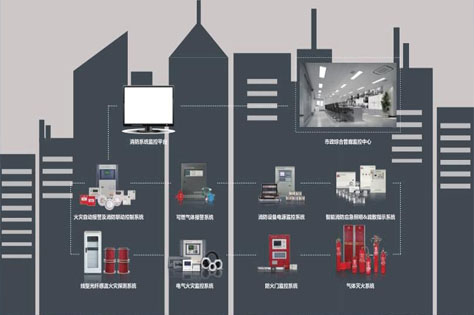With the development of cities and the improvement of economic and consumption levels, large shopping malls and commercial centers have sprung up like mushrooms after rain. The population flow is large, and there are many flammable items. The safety of the shopping environment is also closely related to brand management. Therefore, strengthening fire safety management, maintaining the health of evacuation routes and indication systems, smoke control, fire separation and other fire protection facilities, is a key concern for large supermarkets and commercial centers.

Main issues
The large number of fire protection points makes it difficult to quickly locate the location of a fire alarm; There are many fire-fighting facilities and a large amount of inspection work; Frequent facility malfunctions and untimely maintenance; Fire exits and evacuation signs, as well as fire-resistant rolling shutter doors, are prone to obstruction and pose multiple fire hazards; The implementation of fire safety management is difficult.

Solution
Our wireless IoT device "Smart Firefighting" is based on meeting the practical needs of "automation" in fire prevention and control, "intelligence" in firefighting and rescue command, "systematization" in daily law enforcement work, and "refinement" in military management. We vigorously utilize and promote new generation information technologies such as big data, cloud computing, IoT, and geographic information, innovate fire management models, and implement smart prevention and control, smart combat, smart law enforcement, and smart management.
1. Smart Fire Protection System Architecture
Our company's independently developed intelligent fire safety service cloud platform (referred to as the Intelligent Fire Protection System),
It consists of a fire alarm remote monitoring subsystem, a visualization subsystem for key areas, a fault arc detection subsystem, and a smart fire wireless monitoring subsystem. The system consists of four modules: the basic data collection subsystem, the unit responsibility inspection subsystem, the remote supervision and management subsystem, and the fire service support subsystem. It has changed the traditional nanny style fire supervision mode, realizing that there are methods for unit responsibility and basis for fire supervision, and forming an internal closed-loop management of fire work between the fire department and social units.
2. Smart fire protection system forms an IoT platform
2.1 Fire Alarm Remote Monitoring Subsystem
We have achieved the sharing and communication of unit alarm information with the fire department. We will filter false alarm information and assist the fire department in obtaining accurate fire alarm information without increasing the personnel input of the fire department.
2.2. Visualization subsystem for key areas
Real time monitoring and viewing of key areas such as the duty status of the building's fire control room and fire exits have been achieved. When a fire occurs, the on-site video of the dangerous area can be stored locally, and if necessary, video transmission can be achieved through 2G/3G/4G networks and linked with the fire alarm remote monitoring subsystem.
2.3 Smart Fire Wireless Monitoring Subsystem
The smart fire wireless monitoring system is a system designed for the actual environment on site, which facilitates construction and information collection. By utilizing the IoT card transmission systems of China Mobile, China Telecom, and China Unicom, stable signal transmission and unlimited transmission distance can be maintained.
2.4 Fault arc detection subsystem
This system detects changes in current waveforms in both time and frequency domains to determine the occurrence of arcs. The system is capable of detecting arcs caused by current distortions inside the circuit and sending arc alarm information to relevant responsible persons' mobile phones and PCs via SMS and network transmission, thereby achieving predictive warning of faulty arcs. Combined with the faulty arc circuit breaker, a comprehensive solution for detecting and preventing faulty arcs has been achieved.
3. Auxiliary decision-making system
Utilizing the latest technologies such as GIS, GPS, and 3D modeling, combined with professional applications such as big data and cloud computing platforms, to provide auxiliary decision support for firefighting and rescue in the fire department
Once a real fire alarm occurs in a networked unit, the system will display multi-dimensional data information such as the fire alarm point unit information, location map coordinates, internal contacts, floor plan, internal hazards, and internal firefighting resources. At the same time, the GIS system will display firefighting resources within a certain range outside the fire alarm point, as well as nearby major hazard sources, providing auxiliary decision-making support for combat.
The system simultaneously sends alarm information to the nearest fire brigade, dedicated fire brigade, micro fire station and other rescue forces, and conducts optimal path planning to carry out firefighting and rescue operations.

4. Data analysis
Provide decision-makers and managers with detailed, accurate, and efficient data references for firefighting assets, operations, and maintenance work.
5. Mobile maintenance services
Create high-quality mobile maintenance services and bid farewell to traditional paper work orders. Automatic archiving of work logs to avoid complex document work.
6. Advantages
(1) Monitoring center, unified management, cost reduction
(2) Real time monitoring and early warning notification of fire alarms, malfunctions, and hidden dangers, and timely handling
(3) Real time monitoring of the operation status of fire-fighting equipment, automatic reporting of abnormalities
(4) Multi protocol data collection, accurate and reliable
(5) Cloud platform integrates fire data center and visual reading
(6) Regularly push monthly fire safety reports, and quantify fire safety management
|


